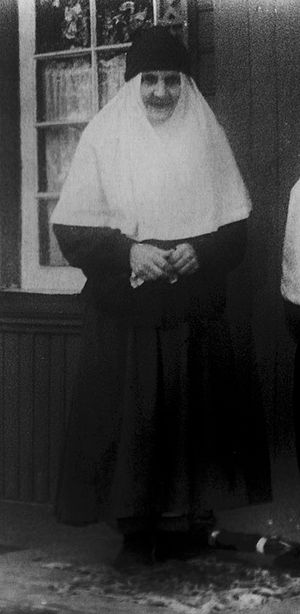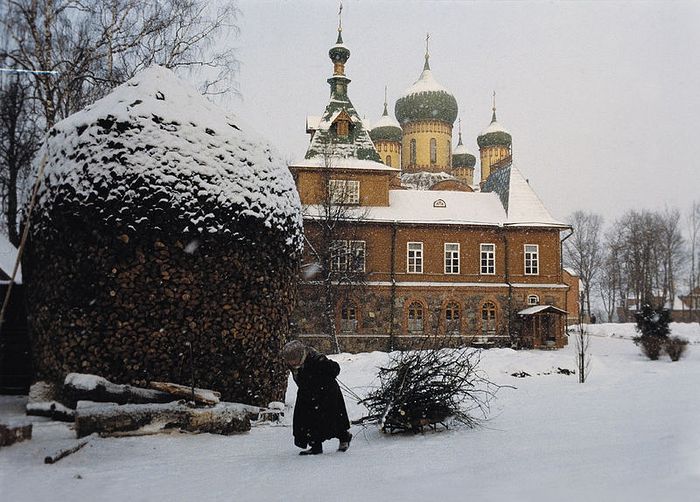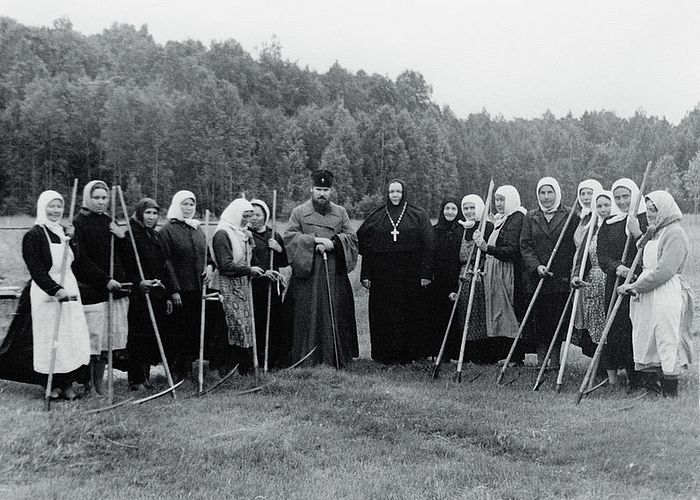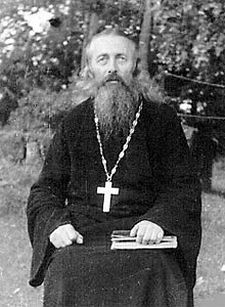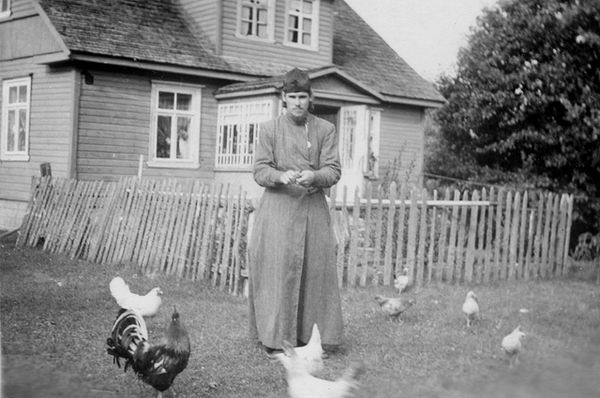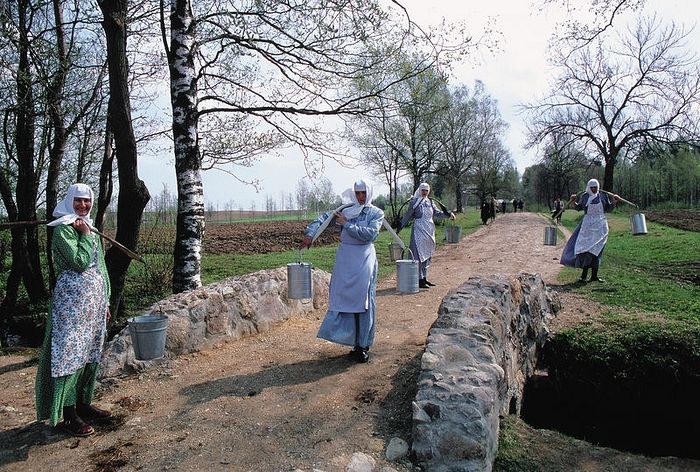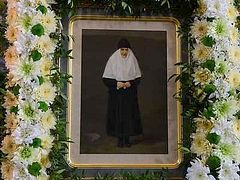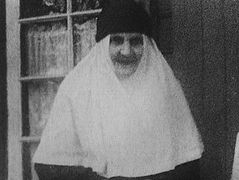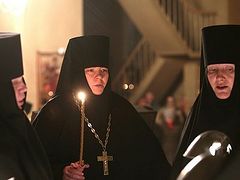By the decision of the Holy Synod of the Russian Orthodox Church, Blessed Ekaterina (Malkov-Panin) of Pukhtitsa Monastery in Estonia was numbered among the locally-venerated saints on March 7, 2018, which was liturgically celebrated at Pukhtitsa Monastery on March 20. Her glorification had been petitioned by Abbess Philareta (Kolacheva) of Pukhtitsa Monastery, where the memory of the blessed eldress, known for her gifts of clairvoyance and healing, is warmly venerated. The Synod established that she will be commemorated annually on April 22/May 5, and should her remains be uncovered, they are to be considered holy relics.
We present below the life and sayings of the wonderworking Eldress Ekaterina, as well as several recollections of her from her fellow monastics and pilgrims to the monastery.
***
O Jesus, Thy Lamb Ekaterina crieth unto Thee exclaiming: / “Thee, O my Bridegroom, do I love, /
and seeking Thee I endure Martyrdom, / by Baptism I have become crucified and buried with Thee, /
and now I suffer for Thy sake, so that I may reign with Thee. / I die for Thee so that I may live with Thee. /
As an unblemished sacrifice do Thou receive me / who in love sacrifice myself to Thee.” /
By her intercessions, O most Merciful One, save our souls.
Troparion to a Maiden Martyr, General Menaion, Tone 4
Mother Ekaterina was born on May 15, 1889 in Finland, in the Sveaborg Fortress into the family of the military engineer Vasily Vasilievich Malkov-Panin. Vasily Vasilievich was an outstanding military engineer and one of the direct creators of the fortification structures of the largest military consolidations of Russia (as the designer of the project along with the famous professors Buinitsky and Velichko). Ekaterina’s mother, Ekaterina Konstantinovna, was the daughter of a merchant of the first guild, the owner of the Red Village paper mills Konstantin Petrovich Pechatkin.
There were six children in her family. Ekaterina Konstantinovna prepared the children for a secular life, and she was frightened by the “excessive religiosity” of her eldest daughter. Ekaterina really loved to go to the holy monastery located not far from their estate. The girl was distinguished by her kindness and sympathy, often interceding for the servants, acting as a mediator between her mother and the workers, and it sometimes happened that she had to listen to long reproaches before she received what she requested.
At first, the military engineer’s family lived in the Sveaborg Fortress and then moved to Helsingfors (Helsinki). In 1898, Vasily Vasilievich Malkov-Panin was assigned to the Chief Engineer’s Office located in St. Petersburg, and the family left Finland. A little while later the family relocated to Gatchina, where a realschule1 was opened at that time.
Katya and her sister went to high school, and her brothers went to the realschule. Ekaterina’s brother George remembers: “My parents chose Gatchina for a number of reasons. Our family was accustomed to living in a small city where the children could play sports. Gatchina, with its wonderful parks, was quite suitable in this respect. We rented an apartment with a garden and all amenities on Bagoutovskaya Street—Gatchina’s Nevsky Avenue2… Our residence was not far from the Warsaw Train Station. It took my father less time to get to the Chief Engineering Office in the Engineering Manor than it would have from any Petersburg suburbs. It took me twenty minutes to get to the realschule.” (In May 1904, George Vasilievich Malkov-Panin graduated from the Gatchina realschule as the top student of the first graduating class. He received a reward of the luxuriantly published essay of Prince Ukhtomsky The Journey of Tsarevich Nicholas to Japan. He personally received the book from the hands of Empress Maria Feodorovna in Gatchina Palace…)
At the beginning of the twentieth century, Ekaterina studied in the science department of the Bestuzhevsky courses. Upon graduating from the courses in 1912-1913, she worked for the Entomological Society. In 1914, Ekaterina entered the Sisters of Mercy courses and at the same time began working in the city’s free hospitals. She later worked in the base hospital, then transferred to the flying squad of the Community of St. George, whose Sisters of Mercy helped wounded soldiers who were carried off the field of battle.
From the recollections of Schemanun Seraphima (Demor):
“Still a young girl during the First World War, she was sent to the front as a nurse, where she took care of the wounded who had just been brought from the field of battle. She saw human suffering and death there, face to face. All of this finally tore her away from a secular way of life.
“In 1919, she went to Narva with her family (Estonia was already an independent country), where she took a job as a maid for some wealthy people and to work in the garden, specifically to habituate herself to physical work and to prepare for life in a monastery.
“Not far from the city of Narva is the city of Jõhvi, where Pukhtitsa Monastery is established on the holy mountain in the village of Kuremäe. The thirty-three-year-old novice headed here. A group of novices, headed for work in the fields, met her at the gates of the monastery. One of them laughed at Katya because she was wearing a hat, so Katya went up to this hapless novice and put her hat on her with the words, “I don’t need it anymore, but it will come in handy for you!” And thus it happened in the future—the novice could not withstand the trials of monastic life and returned to the world.
“Thus, from her first step into Pukhtitsa Monastery, blessed Mother Ekaterina’s miraculous gift was evident. Thereafter, she labored fervently at all her obediences, except for some of them, unexpectedly (for example, she did not want to mow the grass, probably out of pity for nature, for the creation of God). But in all of her deeds and acts, she often seemed very strange and accompanied her actions with a tirade of mysterious, unrelated words, some of which would be addressed to a specific person and event and which would precisely come true in accordance with her veiled predictions…”
***
Ekaterina was accepted among the number of novices of Pukhtitsa Monastery on July 5, 1922. From the first days of her life in the monastery, Ekaterina began to behave abnormally, strangely, at times acting a “fool,”3 but not quite openly yet. She was soon transferred to Gethsemane Skete. She loved to work, scrupulously trying to fulfill her obediences, but she did everything in an unusual way. She often walked barefoot, or in stockings, and most often in slippers sewn from felt. They would give her boots in the monastery, but Blessed Ekaterina would give them to the faithful. She wore felt boots in the winter, but never leather ones.
One time she was walking around the monastery yard in slippers in inclement weather. One sister, seeing her like this and taking pity upon her, asked her, “Mother Ekaterina, can I give you some boots?” She stopped and looked at her fixedly. “Well, okay, you can,” she said, but having thought and stepped back a little, she turned and asked, “They’re not leather, are they?” “The heels are covered.” “I won’t take them!” “Why, Mother Ekaterina?” “Because we have to expose your own skin, not someone else’s,” she said.
The blessed one would often disappear, not returning for a long time. One day she went to the forest for mushrooms and didn’t return for several days. They sent some sisters after her and they found the ascetic in a hut on Red Hill, not far from Jaama, weakened by many days of fasting. (The small hut, made of intertwined branches, was full of mushrooms, which they put into several baskets.)
Blessed Ekaterina once fasted strictly for seven days (neither eating nor drinking). One of the nuns was a witness to this podvig, as the blessed eldress lived in her cell during these days.
Blessed Ekaterina’s “expedition” in search of the “old style” was long remembered by the inhabitants of the monastery. After this “expedition,” she had to ask the forgiveness of all the sisters. It happened when the Church in Estonia changed to the new calendar. This was before Estonia became part of the Soviet Union, and there was a border between the states. The border guards detained the nun on Soviet territory and they demanded she pay a fine, otherwise threatening her with jail. The monastery didn’t have such a large sum and had to write a letter to Blessed Ekaterina’s brother, who then sent the money. While the investigation was underway, the ascetic was languishing in detention. (Perhaps the blessed one’s ardent prayer brought the time of “the return of the old style” closer for the monastery.)
The Gethsemane Skete was abolished at the beginning of World War II. All of the skete nuns returned to the monastery, but Mother Ekaterina was released home to take care of her sick and elderly parents who were living in Tallinn. (Ekaterina’s parents had moved to Estonia in 1919.) She buried her mother in 1942 and continued living with her father. Blessed Ekaterina would go to the Pukhtitsa Monastery dependency in Tallinn, and foretold its closure (nearly twenty years ahead of time). In 1947, the ascetic buried her father and returned to the monastery. (Nun Ekaterina’s parents—Ekaterina Konstantinovna and Vasily Vasilievich—were buried in Tallinn’s St. Alexander Nevsky Cemetery.)
Blessed Eldress Elena of Pukhtitsa reposed on November 10, 1947, and Blessed Ekaterina became her successor: Having taken upon herself the heaviest podvig, she began to play the fool openly.
The chosen of God, led by the Holy Spirit, knew that the whole of her long life would be connected with great sorrows, but she believed that the Lord would not abandon her, for without God’s help it would be impossible to bear this cross. The holy fathers say that if not for sorrows, there would be no salvation. St. Nikon of Optina said, “The Lord helps us in sorrows and temptations. He does not release us from them, but gives us strength to bear them lightly, and to not even notice them.”
Mother Ekaterina dressed in a peculiar fashion: In the summer she would wear a black tunic and a white apostolnik,4 on top of which she would wear a black hat or a black scarf. In the winter she would wear any light katsaveika5 over her tunic, sometimes girded with a white scarf. She didn’t wear warm clothes (coats and shawls). The blessed one always prayed at night.
Blessed Eldress Ekaterina would advise the novices to live simply and not to condemn others. She would say that the reason for condemning is an inattentive spiritual life. She called all to battle with pride, to humble themselves. She would say that pride absorbs every virtue. The eldress taught frugality, relating to everything the Lord gave her with reverence. In particular, she would say about water: “You will answer for every drop.”
The nuns recalled that Mother Ekaterina sometimes imposed a special fast upon herself, explaining that she was preparing to die, and usually it was for the death of one of the sisters. The sisters also noticed that if the blessed one said she was fasting strictly because she was preparing for her tonsure to the mantia, it meant someone else’s tonsuring was coming up soon.
From the recollections of Nun G.:
“One time, she had only Holy Water and some pieces of prosphora throughout the entirety of Lent, but on Holy Friday she drank an egg in front of everyone. After that, who would believe that she was fasting?! She did this so they wouldn’t notice her podvigs, but just consider her stupid.
“She would say about visiting pilgrims: ‘God’s travelers have come to the Mother of God!’ The people came in an endless stream to see Mother Ekaterina. Many would come to the monastery specifically to see her. The number grew with every year. The monastery received many letters in the name of the abbess with questions for Mother Ekaterina and with requests for prayer. Mother Ekaterina would behave in different ways with those who came to her: With one she would speak allegorically, and with another simply; she would speak with some for a long time, while others she immediately escorted out with anger. People’s souls were open to her. She would immediately give out whatever was brought to her by those who revered her. She didn’t carry even a penny on herself, but would give money away with great discernment.”
***
According to St. John Climacus, “Meekness consists in sincerely and without embarrassment praying for others who have offended you.” Blessed Ekaterina was meek and merciful; she forgave all who were spiteful to her. She prayed for those who disliked her, understanding that the Lord permitted it so that she would pray for the salvation of the souls of those who erred, that the spirits of anger would depart from the offenders, that her heart would be filled with love for others, and that she would return them to the grace of God.
When one of her ill-wishers (a middle-aged nun) was dying in the hospital from purulent appendicitis and the doctors couldn’t help her, the blessed one fervently prayed for the salvation of her soul. She called on the other sisters to pray: “Pray! Pray! Mother N. is dying! She’s not ready! Pray…” By the ascetic’s prayers, Nun N. recovered, to the doctors’ amazement.
St. Nikon of Optina says, “Persecutions and oppressions are useful for us, for they strengthen faith.” St. Symeon (Zhelnin) notes: “He who desires to save his soul must remember that it is impossible to be saved without sorrows and temptations, and therefore he should thank God for all that is sorrowful… Sorrows are mainly the lot of those being saved in the last times: We must through much tribulation enter into the Kingdom of God (Acts 14:22).”
According to the testimony of Schemanun Seraphima, not all of the sisters loved Mother Ekaterina due to her frankness. Some of the sisters insisted that Blessed Ekaterina go to a psychiatric hospital. The doctors didn’t recognize her as sick, but the patients severely beat her in her hospital room, instigated by a demonic power. (And fear not them which kill the body, but are not able to kill the soul: but rather fear him which is able to destroy both soul and body in hell (Mt. 10:28.)
Returning from the hospital, Mother Ekaterina settled into the hospice. One of the oldest sisters, Nun N. recalls: “When I replaced old Mother Kapitolina in the hospice, I would often see how Mother Ekaterina went out to pray in the field at night. She would come back in the morning all wet. She almost never slept at night, just prayed; or she would get up at midnight, pray in a corner, and then go around to every bed and sing, ‘Behold, the Bridegroom comes at midnight’ in a hushed voice.”
The monastery gatekeeper Novice A. told about how she once saw how the ascetic prayed all throughout the cold January night, having laid a blanket down on the snow.
In speaking about the ascetic, the sisters would recall her wonderful, big gray eyes—sometimes child-like, calm, affectionate, smiling, and sometimes serious and severe, penetrating into the very depths of the human soul.
The monastery’s spiritual father Hieromonk Peter (Seregin) would say, “…Renounce the passionate darkness of your mind and heart and you will see the Divine light within yourself and in your neighbors. Don’t forget the apostolic words: Ye are the temple of God, and the Spirit of God dwelleth in you (1 Cor. 3:16).” The blessed eldress was guided by these words.
***
There are many testimonies about instances of healings by the ascetic’s prayers. We will present only a few testimonies from the book The Blessed Eldress of Pukhtitsa Monastery:
Sister M. was hospitalized for a long time with a serious illness. There she saw Mother Ekaterina in a dream, having come to visit her in the hospital. She blessed her with a cross and said, “I know it’s hard for you.” Sister M. woke up and felt a blessed peace in her soul. At the end of her treatment, Sister M. returned home in good health. Some time later Sister G. told her, “I went to see Mother Ekaterina once, and she suddenly started talking to me so strictly and demanding: ‘Pray for M., it’s difficult for her in the hospital. You should pray for her!’”
According to the sisters’ testimony, Mother Ekaterina did not bless them to go to doctors. Remember the words of the holy fathers about how infirmities motivate us to do good, and that those who endure this meekly ask God to forgive their sins and glorify His name, and that they would be pardoned.
Maria from Kronstadt says, “I had problems with my leg; it had scabs, rashes, and boils, like eczema. I went to see Mother Ekaterina. She told me to take my stocking off, looked at my leg and said, ‘May God grant that this will pass!’ She took the scarf from her head and tied my leg with it. When I got home, my leg was clean.
“My husband had a sore throat for a long time. They treated him in Kronstadt, then the doctors sent him to Leningrad, but they didn’t help him there. I went to Pukhtitsa. As I was going in to see Mother Ekaterina, I hadn’t even managed to say anything yet, and she asked, ‘How is your Ivan?’ ‘His throat hurts,’ I replied. ‘Is he being treated with electrotherapy?’ ‘Yes,’ I said. Then Mother Ekaterina sent for Fr. Peter to serve a moleben. I returned home and told my husband, ‘Mother Ekaterina won’t allow you to get electrotherapy.’ He replied, ‘And I’m not sick anymore; it all passed already!’ He had been sick for a long time, and even fell into despondency, and here, he received healing by the prayers of Mother Ekaterina.”
From the journal of the eldress’ spiritual father Hieromonk Peter (Seregin):
“Foolishness for Christ’s sake or intentional stupidity: Mother Ekaterina clarified this question well. ‘Stupidity is a sin,’ she said, because the person isn’t using the gift of God, burying his talent in the ground, like the lazy servant.’ But about herself she said, ‘I renounced my intelligence, needless to say, for the glory of God, subjugating my whole will to Him. I have offered my life as a gift to God. But God gives man the grace-filled gift of higher reasoning and enlightenment. Divine revelation is received by prayer.’”
The blessed one’s spiritual father later wrote in his diary: “We must seek for knowledge of the world and man not in human judgments, but in the revelation of God, through a clear conscience. For all that is human is passionate, but we receive that which is perfect from the grace of God.”
The ascetic managed to be purified from passions. It can be supposed that it was precisely for her great humility, childlike faith, simplicity, and gentleness that she was accounted worthy of the gifts of the Holy Spirit—clairvoyance and the gift of healing.
St. John Climacus said, “Meekness is the quiet constitution of the soul, free from all cunning. Rightness is a non-visual idea, a sincere temperament, an unfeigned and unscripted word.”
Blessed Ekaterina wrote to one of her spiritual daughters in a letter, “When I gave my mind to the Lord, my heart became vast…”
Fr. Peter, revering the great ascetic who took upon herself the podvig of foolishness for Christ’s sake, would say that she was a mother to him by the power of prayer.
In the book of commemorations of the reposed of Metropolitan Manuil (Lemeshevsky) (1884-1968), it said over Mother Ekaterina’s name: “From those who did not want to be glorified.”
The following case testifies to the blessed one’s modesty. Meeting with Blessed Ekaterina, one of the nuns of the monastery was unable to hold back her tears of repentance. Mother immediately became serious and told her, “You should cry in front of an icon!”
In the 1950s, the future Mother Glaphyra went to see Blessed Ekaterina together with her friend, who, like her, dreamed of remaining in the monastery her whole life. The blessed one told the girl that she wouldn’t stay in the monastery, and added these strange words: “Go to the matushkas!”—”Matushkas—that’s nuns,” the girls thought, at a loss. But a little while later, having not been accepted into the monastery, the girl went on a pilgrimage to the Holy Trinity-St. Sergius Lavra and met a seminarian there who became her husband and received the priesthood—thus she became a matushka. But Glaphyra was soon destined to become a novice at Pukhtitsa Monastery.
A disaster occurred once with a woman who was very devoted to Blessed Ekaterina: Her young son fell from the fifth floor. Although the boy was breathing, the doctors said it was unlikely he would survive. The woman began to shout: “Mother Ekaterina, help! Help, Mother Ekatarina!”—to the doctors’ surprise, the boy survived.
In the early 1950s, there was a certain hieromonk serving in the monastery. Blessed Ekaterina would wear a colored embroidered belt like the hieromonk had, and wouldn’t give him a pass: She stood across from him during the services, by the ambo, yelling and acting crazy. Soon this hieromonk left for the world and got married, giving up his orders.
The eldress knew many years ahead of time who would become the patriarch. She predicted their patriarchal ministries to Vladyka Pimen (Izvekokv) and Vladyka Alexei (Ridiger).
From a story from Schemanun Seraphima (Demor):
“Mother Ekaterina could foresee the future fate of man. Thus, for example, when a young priest no one knew, Fr. Alexei, was serving in the parish church in Jõhvi, she entered the church after a service and started to sing, ‘Most Blessed Master, bless!”’ And the priest, smiling, joyfully went to bless the blessed one. It seemed like a joke to everyone, but many years later, the name of the First Hierarch of our Church became known to all…
“Mother Ekaterina had the habit of comforting those in sorrow. Once she went to the banya where the young Novice Valentina (the future Schemanun Valeria) was working. She started talking about something, often repeating herself, how her head was spinning, how she fell, and how much blood there was. When she finally left, Valya heated the oven in the banya and warmed up from it. Staggering, she went outside, passed out, and fell face down on a rock, badly injuring her face…
“Mother Ekaterina was distinguished by amazing love for the sisters. Life in the monastery was austere then, and the sisters were not always well-fed. Mother Ekaterina headed for Jõhvi, unhurriedly, and bought some barankas with money from benefactors. She wore them around her neck in a big ring6… and left the monastery for the fields after dark. The sisters would scythe far from the monastery, going out to the hayfield by horse. Therefore, to get there took nearly all night. The sisters would leave to scythe in the field early in the morning, and suddenly they saw through the field Mother Ekaterina coming towards them from the forest, wet up to the waist from dew, all covered with barankas, smiling and glistening with love. So joyously did she traverse the difficult path of barankas!
“Mother Ekaterina was able to overcome troubles and shield people from danger. Her word was trusted and her advice followed. Thus, Mother Ekaterina once dissuaded one woman (a pilgrim) from leaving at the designated time, and thereby saved her life from an accident, because the bus she was planning to take crashed, and many passengers were inured…
“Mother Ekaterina bore inordinate podvigs of fasting and prayer and denied herself everything necessary. She could often be found at night either near the cathedral, or near the Spring of the Mother of God, praying and mortifying even the natural bodily needs. Sometimes it was unclear where she lived, wandering about the sisters’ cells, foretelling by her appearance either their move to a new cell, or new trials.
“Mother Ekaterina was greatly revered by the pilgrims and all the laity. The monastery became famous thanks to her, because many came not just to Pukhtitsa, but to Blessed Mother Ekaterina.”
***
Blessed Ekaterina went into reclusion before the beginning of Great Lent 1962 when the threat of closure hung over the monastery, remaining in fasting and prayer until Pascha… By her prayers, the monastery was not closed.
From the recollections of Nun E.:
“Mother Ekaterina asked, ‘Do you see how the saints go into the church?’ ‘No.’ ‘I see them. They come before the people. They come and come and come, one after the other… Get to church sooner, before the service has started.’
“I went to see Mother Ekaterina once in the winter of 1968, and she asked me, ‘Who is our abbot?’ ‘I don’t know.’ ‘How do you not know? Who’s the abbot? Who helps Mother?’ I was silent. ‘Look, that’s the abbot!’ she said, pointing to a portrait of dear Batushka John of Kronstadt.”
***
Once it was revealed to the blessed Eldress Ekaterina that the holy Righteous John of Kronstadt celebrated the service together with Fr. Peter.
In April 1966, Novice Ekaterina was tonsured into the mantia, privately, in the abbess’ chambers, by Archbishop Alexei of Estonia, the future patriarch, giving up her previous name.
In the last years of her life, the blessed eldress rarely left her home, mostly lying down. If she got up and unexpectedly appeared somewhere, it was a great event and meant that something significant was going to happen in the house.
From the memories of Nun G.:
“…It was 1958. I had many chances to be with the blessed eldress then. She had the Jesus Prayer. I would go see her and bring her lunch or stop by to ask her something, and she would be lying quietly, saying almost to herself, ‘Lord, Jesus Christ…’ So many times I found her this way. Or I would hear, ‘Lord, forgive me—forgive everything!’ She said it with great feeling, thereby teaching me. She always had the Apostol, Gospel, and Psalter with her, and she read them often. Someone would come and read aloud to her, and she would read it to herself… I often heard the edification from Mother: ‘Such was my heart—to comfort everyone, but not to pity myself!’”
“The holy fathers asked God not that He might take away their torments and sorrows, but that He might give them the patience to endure them meekly… Sorrows… and torments are a means, an automobile… which takes us to Paradise…” (Elder Ephraim of Katounakia)
According to the nuns, the blessed Eldress Ekaterina had a constantly inflamed mucus membrane in her mouth, she suffered from a chronic cold, she had polyps in her nose, and she had to breathe with her mouth. There were some signs that spoke of a stomach disease, and her almost constant muffled cough spoke of a lung disease. The Lord alone knew her suffering; she didn’t express it outwardly at all. In one of her last letters, the blessed one wrote, “How easy it is to take a podvig upon yourself, how hard it is to finish it…”
On May 5, 1968, the feast of the Myrrh-bearing Women, Mother Ekaterina communed of the Holy Mysteries of Christ for the last time. Abbess Barbara, Abbess Angelina, and Nun Nektaria surrounded the dying eldress that day.
Mother Ekaterina was lying on her right side, covered by her mantia… The Kazan Mother of God, a cross, and a candle were placed at the head of her bed. With the abbess’ blessing, the wonderworking icon of the Dormition of the Mother of God was brought from the cathedral, and they blessed the dying eldress with it.
People started coming one after the other to bid farewell… They read the prayers for the dying twice, then Sister E. started reading the Akathist to the Kazan Icon of the Mother of God… While reading the thirteenth kontakion, “O All-Hymned Mother!” Nun Ekaterina quietly reposed… It was 2:19 in the afternoon…
After the necessary preparations for placing the body into a coffin, twelve prescribed rings of the monastery bells announced the blessed eldress’ repose. At 5:00 PM, the coffin with the body of the departed was carried into the cathedral, and the first panikhida was immediately celebrated, after which the solemn All-Night Vigil began for the feast of the holy Great-Martyr George the Victorious. Another panikhida was served after the All-Night Vigil, then the unceasing reading of the Psalter began at the reposed’s coffin, being interrupted only by the services and panikhidas.
The next day, the number of people noticeably increased during the Liturgy, and by the time of the evening service, the church was full of people. After the evening service, many remained at her casket the whole night and prayed while reading the Psalter. At the “Glory” at the end of each kathisma, all the people sang, “With the saints give rest, O Christ, to the soul of Thy servant…”
On Tuesday, May 7, the funeral rite for the reposed eldress was served after the Divine Liturgy…
Mother Ekaterina was buried near the altar of the Sts. Nicholas and Arseny Cemetery Church, on the south side.
To this day, nuns and pilgrims come to Blessed Ekaterina’s grave to ask for her prayerful intercession before the Lord. There are numerous testimonies to the ascetic’s help after her blessed repose.
B. F. recalls:
“By the grace of God, a group of pilgrims from Riga arrived at Pukhtitsa Monastery in late November 2007. There were several hours before the start of the evening service, so we were able to go to the holy spring. Besides, I really wanted to commune the next day, and, as we know, you don’t go in a holy spring on a day that you commune, and therefore, despite the fatigue, I went to the spring the day we arrived. (I had earlier heard that there’s a bathhouse next to the spring where the water never freezes, even in the frost, and miraculous healings occur with believers the whole year round.) There was a light frost that day, about 19°. The path went through the monastery cemetery, and I first decided to look for the grave of Blessed Nun Ekaterina, to ask for her prayerful help. I found her grave in the snow-covered cemetery immediately, and the path to the ascetic’s burial place was cleared.
“There were candles with the decorative artificial flowers by the cross at the grave. Having prayed for the repose of blessed Eldress Ekaterina’s soul, I asked for her prayers so I wouldn’t be afraid of diving into the cold water in below freezing temperatures. By the prayers of Mother Ekaterina, I plunged into the spring, not even thinking about how cold the water was. I was only afraid of slipping on the icy steps we had to go down to get into the water, holding tight onto the wooden railing. I didn’t feel the cold. I immersed myself three times with prayer, and quickly got dressed. The water of the holy spring took away my fatigue and I felt a surge of strength. I quickly dressed without drying off and briskly ran into the guest building, wondering to myself where such strength came from. Everything was great, but when I returned to my cell, I felt very dizzy. I must confess that I have weak blood vessels, and I have headaches and dizziness often enough. I had to return to the cemetery and ask for the blessed one’s prayerful help.
“When I had gathered some snow from Mother Ekaterina’s grave in my hand and washed myself with it, I got noticeably better. After that I found blessed Mother Elena’s grave and prayed for the repose of her soul and asked her prayerful help and put some snow from her grave on my forehead, and I immediately felt relief. In gratitude for their help, I lit some candles at the ascetics’ graves that had been left by another pilgrim earlier. (A small candle in a plastic glass at the grave of the blessed eldress Nun Ekaterina, intended for a few hours, burned much longer than usual [15 hours], and the next day, having found it, I was very surprised. Truly, the miracles at her grave never stop.)
“Before leaving, I gathered up some snow from the grave of both ascetics. A few days later, already at home, I suddenly felt an incredible weight—my shoulders were pinned down as if someone had heaved a heavy sack onto them, and my arms immediately started hurting. (The same thing had happened a few years ago, and it got better after I read the Akathist to St. Nicholas and Psalm 90). This time I immediately started rubbing my shoulders and arms with the thawed water from the ascetics’ graves with the words, ‘Let God arise and let His enemies be scattered!’ The pain was gone immediately. Glory to God for all things!
“The amazing thing is that there were several vials with blessed oil and Holy Water from Pukhtitsa Monastery on the table in my room, but for some reason I grabbed this bottle, subconsciously relying on the speedy help of the ascetics whose graves I had visited not long ago. I had heard more than once that before the glorification of the saints of God, especially many miracles happen by their prayerful intercession, and the Lord will likely soon glorify His chosen ones!7
Grant rest, O Lord, to the souls of Blessed Eldress Elena and Blessed Eldress Ekaterina, with the saints give rest, and save us by their prayers!”
***
Spiritual Advice and Instructions of the Blessed Eldress Nun Ekaterina
Pride is the devourer of all virtue.
Novices should not have their own will, but God’s!
God gives man the grace-filled gift of higher reasoning and enlightenment. Divine revelation is received by prayer.
Treat others tenderly, cheerfully, and with love… Serve them with love, meekness, and patience… You will be calm when you have patience, humility, and love.
Keep yourself from anger and irritation. Accustom yourself to forgiving offenses…
To young novices, whose moods changed often, the eldress would advise: “You must establish yourself firmly and work on yourself, that your podvig would be unto salvation.”
The eldress would advise people in despondency to ceaselessly repeat, “Lord, save me, I am perishing! Lord, save me, I am perishing!”
To the question, “How can we be saved?” Blessed Ekaterina would answer, “Live simply. Try to condemn less. Condemnation is from an inattentive spiritual life.”

